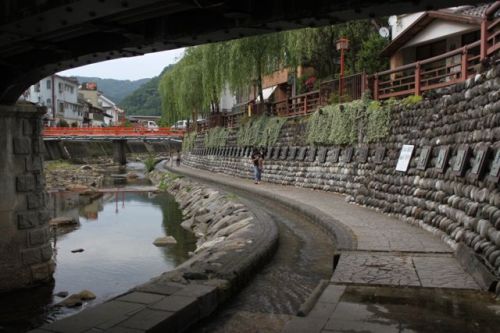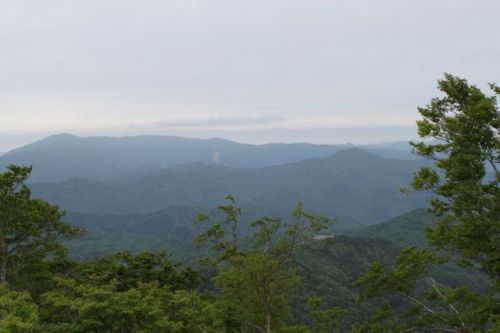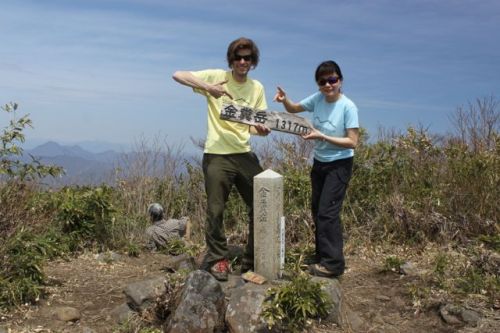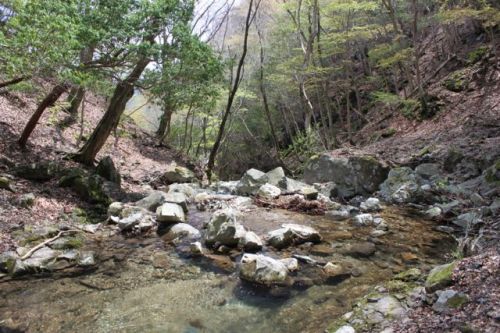I have a self-imposed cutoff day of July 1st, where I go into hiding until the first cool winds of autumn push out the oppressive summer heat. Yes, June can be unbearably hot and humid, but depending on the rain, it can also offer a few pleasant days with relatively low humidity. Relatively.

A clear weather day presented itself, and on a weekend no less. Paul M. was itching to get out, and I was itching to put another notch into my Kansai Hyakumeizan bedpost, so off we went to the hills of northern Hyogo for an assault on my 63rd mountain.

Mt. Nagusa. The mountain of 7 Seeds if the kanji are to be trusted. 683 meters high. Hardly a stalwart among mountains but one should not judge on size alone. Look at Mt. Aoba, just 10 meters higher. One slip on that monster and you can kiss your ankles goodbye.

We headed north on the JR Bantan line to Fukuzaki, where our only option to the trailhead was a 15-minute taxi ride. Our driver willfully abliged, handing us his business card upon exiting the cab at the deserted trailhead. The first part of the path was along a quiet forest road, shaded from the sweltering heat of the sun by a row of neatly crafted cedar trees. My GPS had a hard time picking up satellite reception, so for the time being I left it dangling below my shoulder strap until climbing higher above the constricted valley.

After half an hour we reached a large wooden gate marking the entrance to the ruins of Sakumonji. A grand temple complex once stood on the slopes of this very mountain, the waterfall of Nagusa providing the perfect setting to esoteric Buddhist training. The temple was torn down sometime during the oppressive Meiji era regime, replaced by a nondescript shrine overlooking the scenic falls. We left the road and entered the forest just beyond this symbolic gate for the 1km horizontal tramp to the waterfall.

At the falls I finally connected to a satellite and mapped out the course. The real climb began here, just to the left of the shrine via a constricted trail built without regard the the natural contours of the land. Steep was an understatement as the course made a beeline towards the summit. Views opened up intermittently to the tranquil and lush valley below, while above us the humidity threatened to squeeze the very life out of us, or at least the last of our sweat reserves.

After an hour we topped out and were rewarded with splendid views northward to Mt. Seppiko. Due to temperatures in the mid-30s, the only logical alternative was to retrace our steps back to the start of the hike. Heat and humidity will do wonders to logic, however, and somehow we talked ourselves into completing a more challenging loop hike via a pointy prominence called Nagusa-yari, named after its more famous older father in the Japan Alps. The trail lost altitude via a series of chains and fortunately entered a thick forest that blocked out the sunlight. The woods also cut us off from the cool breeze wafting through the exposed summit, so our pace slowed to a crawl as we continually cleared the sweat from our heavy brows.

It was a long, truly dreadful 3km climb to the spear-like crown of the summit, which only offered partial views off the less wooded eastern side. From the top, the trail once again dropped to a saddle, following the outline of the rocky knife-edge ridge with steep drops on either side. Nestled directly on this narrow spine we came across a Japanese hornet sitting directly in the middle of the trail. I took a slow step forward, but the hornet raised its eyebrows in anger, threatening to launch an offensive. Not wanting to risk a potentially lethal sting, I shuffled down the leeward side of the ridge, tiptoeing on an exposed rock outcrop while grabbing tree branches to assist in keeping me vertical. Once past the bee I climbed back up to the ridge and met up with Paul, who had simply leapt over the menacing insect, likely pissing it off in the process. I knew if two of us crossed its path one of us was likely to fall victim to its venomous prick.

Out of the danger zone, we traversed over a few smaller peaks with no shade to shelter us from the intense sun beams. Shuffling forward, the shores of Nagusa pond eventually came into view, the trail dropping via a series of meandering switchbacks until reaching the shore. On the far end of the waters sat a day-use hut, which we reached a short time later. The cool comforts of the air conditioner was most welcome. I stripped off my boots and socks and placed them on the entrance steps to air out in the direct sun while we waited for the taxi to pick us up again. We both polished off a liter of Aquarius while attempting to pull our bodies from the brink of dehydration. Despite the immense beauty, perhaps it wasn’t the wisest of times to explore the peak during the height of the sweat season, but the ascent did bring me one step closer to reaching my goal.





























